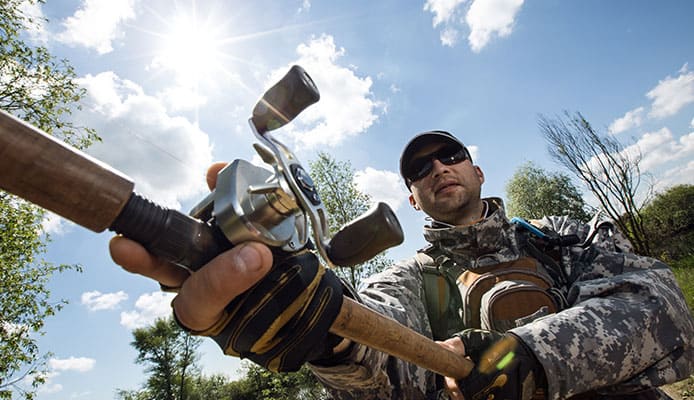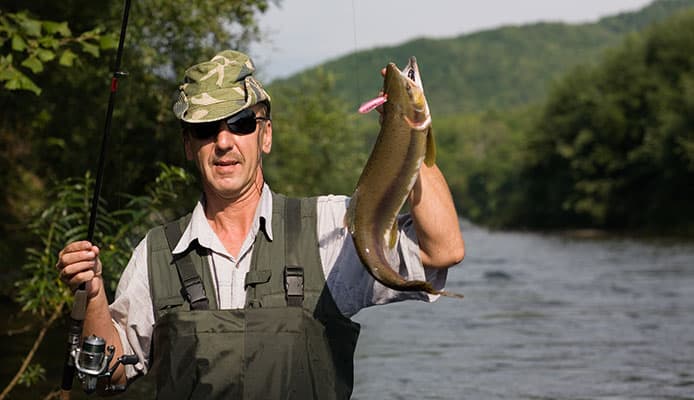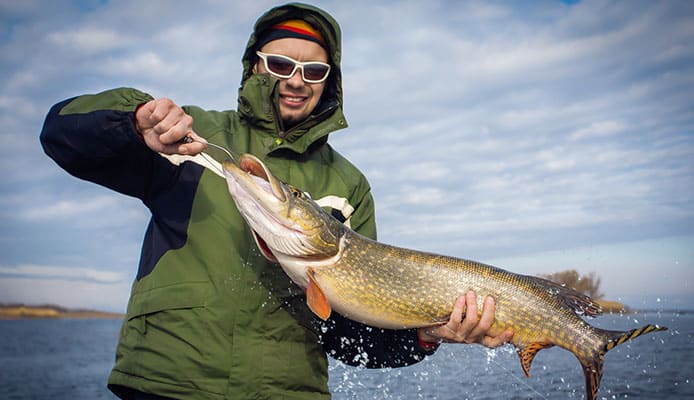
-
1.
-
2.
-
3.
-
4.
-
5.
The best fishing sunglasses help you see deeper into the water and protect your eyes.
When you are out on the water using your eyes to search for your next catch, you’re confronted with several problems. There is the hot sun shining directly on you and there’s the glare caused by light waves bouncing off the water. Not only is it hard to see the fish you’re chasing, you’re at risk of experiencing eye fatigue and damage.
A quality pair of fishing sunglasses can block the reflected light and filter the sun’s radiation thus protecting your eyes from the effects of glare and harmful UV rays. Fishing glasses also help you see more clearly and deeper into the water as you fish making you a more effective angler and making your excursions more enjoyable.
There’s no argument that fishing sunglasses are a must-have accessory for every angler. Long, nice days spent on the water casting and reeling call for the best fishing sunglasses you can lay your hands on. And if it’s a stylish pair, looking cool while enjoying your pastime is a nice bonus. Let’s take a look at the best fishing sunglasses currently.
OUR TOP PICK
Duduma Polarized Sports
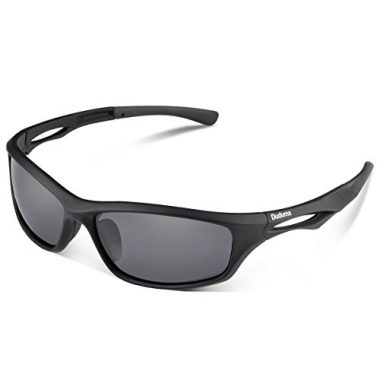
- Stand Out Features - Why We Love It
- Lightweight and comfortable to have on all day
- Stylish design with attractive lenses color options
- Backed by a lifetime breakage warranty on frame and lens
- Great price and value
- Durable construction
EDITORS CHOICE
Oakley Men’s OO9014 Gascan
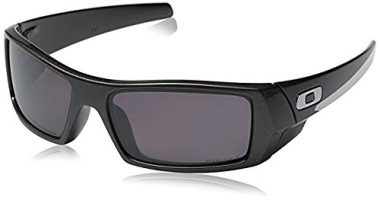
- Stand Out Features - Why We Love It
- Superior sun protection for your eyes
- Stylish design and they look great on
- Lightweight and comfortable fit
- Plastic body/frame is very strong
- Quality and sturdy construction
- Lenses are available in a variety of colors
BEST VALUE
Flying Fisherman Maverick Polarized
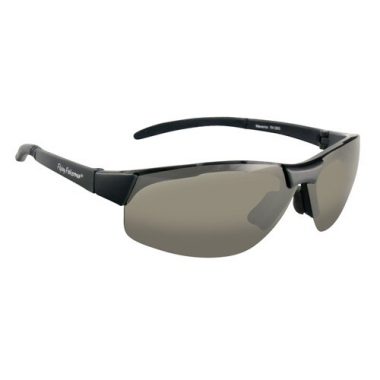
- Stand Out Features - Why We Love It
- High quality and durable construction
- A variety of color lenses to suit different light conditions
- Lightweight and comfortable
- Great value for the price
- Excellent protection from glare and harmful radiation
The Costa Mar Fantail Polarized
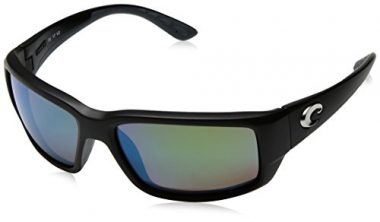
- Stand Out Features - Why We Love It
- Durable construction using high quality materials and technology
- They feature glass lenses which offer the best optical clarity
- The lenses are 99.9% polarized offering superior protection from reflections
- Backed for life by a limited lifetime warranty
- A variety of lens colors to choose from
- Lenses are prescription ready (rx-able)
- They are smudge resistant
- Great fit and comfortable
BEST VALUE
Flying Fisherman Buchanan Polarized
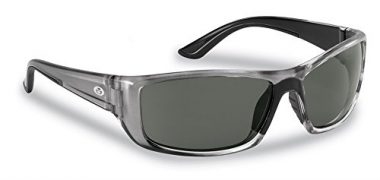
- Stand Out Features - Why We Love It
- Scratch resistant and durable
- Comfortable non-slip fit
- Amazing price and value
- Great style and quality
- Excellent sun protection for your eyes
Maui Jim Mens Peahi
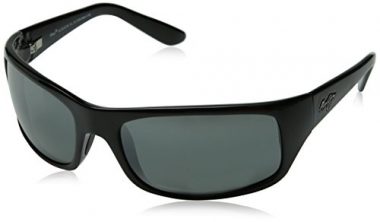
- Stand Out Features - Why We Love It
- Polarized glass lenses clarity and color is great
- Lenses are prescription ready (Rx-Able)
- High quality and durable construction
- They offer great fit and feel
- Attractive with a sport/casual look and feel
- Complete blockage of the sun and its rays
REKS Unbreakable Wrap Around
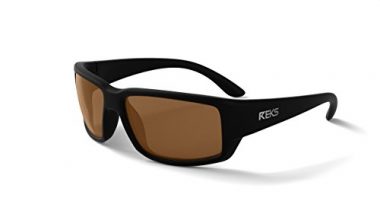
- Stand Out Features - Why We Love It
- Polarized and colored lenses block reflections effectively
- Multicoated lenses for optimal protection and visual clarity
- 100% UV protection
- High-quality polarization to eliminate glare
- Lightweight and fit comfortably
- A wide variety of lenses color options
- Frames can flex without breaking
- High quality with great pricing
Hobie Cabo Polarized Polarized Sport
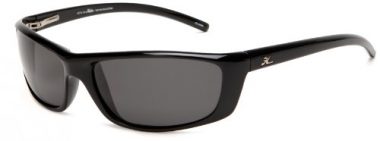
- Stand Out Features - Why We Love It
- They come with a storage case
- Solid and durable construction
- Great eye coverage and visual clarity
- Lightweight and comfortable to wear
- The sleek and streamlined look
- Excellent protection from the sun's radiation as well as reflected light waves
- Company offers amazing customer service and warranty
Wiley X Men’s Ops Saint
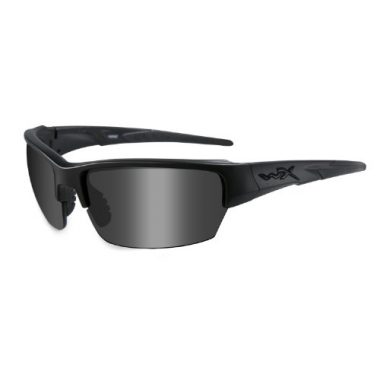
- Stand Out Features - Why We Love It
- Stylish design
- Great, secure fit
- Lightweight and comfortable to wear
- Vision and clarity is good for the price
- Excellent UV protection
KastKing Coso Sport Polarized
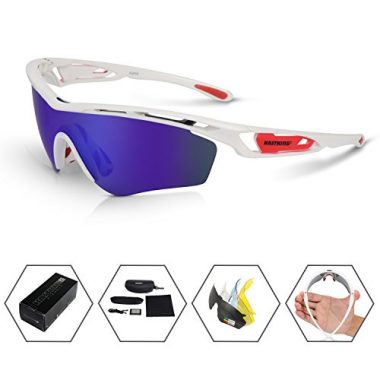
- Stand Out Features - Why We Love It
- Affordable price and incredible value
- Versatile and convenient
- Lightweight and very comfortable
- A safety strap and carrying case is part of the package
- Lenses repel water and fog
- The lenses are interchangeable which makes this set flexible
How To Choose A Pair Of Fishing Sunglasses – Buying Guide
Choosing the right pair of sunglasses for fishing is important if you’re to get the eye protection your need when out there on the water and also benefit from enhanced visual clarity and ability to see deep into the water.
You’ll want to find a pair that works with the type of fishing you’ll be doing and the environment you’ll be angling in. Here’s what to pay attention to when shopping for sunglasses so you can end up with the best pair for you.
Lens Color
To provide optimum vision depending on the conditions, fishing sunglasses may be tinted to reduce brightness or have polarization combined with coloring to reduce brightness as well as glare.
Some are also mirrored so that the wearer can see the outside environment clearly but others can’t see his or her eyes. Mirroring reduces exposure to glare and UV rays and mirrored lenses are good to wear when fishing in sunny conditions. So which color lenses should you choose for fishing?
Don’t just go for the coolest color. Consider the time when you go fishing, the weather conditions, and the light environment you’ll be fishing in to choose the best color lens for fishing. Here are the different color lenses and their effects.
Gray/Smoke Lens Color
Gray reduces light transmission thus lessening brightness and glare and enhancing color and depth perception with minimal color distortion. They shield the eyes from the sun while making it possible to see deep into the water.
They suit bright conditions such as sunny days and offshore fishing. They also work very well in streams and rivers that have a greyish or limestone base. Gray tints are also the go-to for everyday activities on water and land.
Amber, Brown, Copper and Orange Lens Color
These lens colors let light in low light conditions and make the environment appear brighter. These lens colors enable one to see clearly in overcast, cloudy, fog and haze, dusk, and dawn and murky water conditions. However, they offer very little protection from glare and harmful radiation when it’s bright and sunny.
They are a popular go-to tint because they are versatile and work for most situations from sight fishing, driving to everyday activities. Amber is the best for all-around fishing conditions.
Yellow Lens Color
These are able to filter out blue light increasing depth perception and enhancing contrast. They enable clear vision when fishing in overcast conditions such as dense fog. Yellow is the go-to for sight fisherman as it makes it possible to see and distinguish things into the water.
Green Lens Color
Green mirror and tint lenses have an amber/copper base color. They improve contrast and vision on sunny days while reducing color distortion. They are the best lens colors for freshwater fishing and sight fishing when it’s sunny.
Blue Lens Color
Blue and blue mirror tints have a gray base that helps block the harsh direct sunlight as well as the extremely intense light reflections on open water making them the best for saltwater fishing. For offshore fishing, polarization and mirrors are very important to reduce brightness and eliminate glare.
Material
The lens material is an important consideration as it determines how durable your sunglasses will be. Typical lens materials are acrylic, glass, polycarbonate, and NXT polyurethane.
Acrylic
Acrylic lenses are the most affordable option but acrylic sunglasses don’t provide much clarity or protection from UV rays. They only serve as a barrier stopping stray objects from entering the eyes.
Glass
Glass lenses are made from real, ground glass. Glass lenses offer the best optical clarity. They are also durable and heavy-duty. Glass lenses are heavier and more scratch-resistant than polycarbonate lenses but are prone to shattering when dropped or during impact. They also have an expensive price tag.
Polycarbonate
Most sunglasses have polycarbonate lenses. Polycarbonate is a synthetic material that makes for precision lenses that are lighter than glass and more impact resistant. They work well in almost any type of fishing condition. However, they’re vulnerable to scratches and often feature scratch-resistant coatings to overcome this weakness.
NXT Polyurethane
NXT polyurethane is the lightest, offers superior optical performance, is stronger and durable than polycarbonate, virtually unbreakable and doesn’t shatter like glass. It’s the ideal material for running, golf, or fishing sunglasses where the toughness provides optimal eye protection against flying objects like fishing hooks and golf balls. The catch is that polyurethane sunglasses are very rare and costly.
Lens Treatments
Lenses for fishing often have treatments such as polarization, UV, anti-smear, hydrophobic/water repellent, and fog proof coatings applied to improve clarity and offer even more protection to fishermen’s eyes.
UV Protection
UV protection is a must-have feature in sunglasses. Actually, sunglasses were originally made to shield and protect the eyes from the sun’s harsh rays and their damaging effects.
The sun emits harmful UVA, UVB, UVC, and blue light rays that can cause eye damage over time. Too much UV exposure over many years can lead to cataracts and damage to the retina.
Even worse for anglers, the danger posed by the sun’s rays is doubled when out there in the water because of glare.
To offer UV protection, the lens of fishing sunglasses are usually treated with UV resistant materials to shield eyes from the harmful UVA and UVB UV light rays.
The more sun protection offered the better. Most lenses come with UVA protection. Some go ahead and offer UVB, UVC, and blue light protection making them the ultimate for sun protection.
Go for sunglasses that block out at least 99% of UVA and UVB rays. They should also filter 75 to 90 percent of visible light. Look for a sticker or tag indicating that they block 100% of UV rays or those labeled “UV 400,” which blocks all light rays with wavelengths up to 400 nanometers.
The Oakley sunglasses reviewed above offer 100% UV protection filtering of all UVA, UVB, UVC, and harmful blue light up to 400nm. These offer full UV protection.
You might also like: Perfect Fishing Drone
Fit and Style
Sports frames are the best for fishing. Apart from their tough and lightweight construction to suit active performance, they usually have a wrap-around design, nose pads and rubberized temples to ensure a tight, non-slip yet comfortable fit that hugs the face and temples.
The snug fit keeps away ambient light rays as well as hooks, dust, sand, and debris that might hurt the eyes. It also secures the sunglasses to your face preventing them from riding down on hot, sweaty afternoons, when you suddenly move your head or when a strong wind suddenly blows.
If wrap-around sunglasses fit too tightly on your face, there is little air circulation and you can get very hot and sweaty behind the glasses. To avoid this, form-fitting sunglasses often feature vents that let cool air in.
To ensure you get a frame that fits, measure the width of your temple and nose bridge, and compare to the dimensions on the product page to determine the right size to get.
Durability
You want to invest in a sturdy and hard-wearing pair of sunglasses that will withstand the elements and serve you for a long time. The best fishing sunglasses don’t come cheap and you don’t want to find yourself back on the market for a replacement pair after only a few trips.
To ensure you make a durable purchase, pay attention to the construction quality and quality of materials used to make the sunglasses.
Polycarbonate lenses are lighter than glass lenses and more impact resistant. However, they’re vulnerable to scratches. Ensure the lens also have a scratch-resistant coating to overcome this weakness.
Glass lenses are durable and heavy-duty. They are heavier and more scratch-resistant than polycarbonate lenses but are prone to shattering when dropped or during impact.
NXT polyurethane is stronger and durable than polycarbonate, virtually unbreakable and doesn’t shatter like glass. It’s the ideal material for fishing and active outdoor wear. However, polyurethane sunglasses are very rare and expensive.
Warranty
Warranty is another important consideration when shopping for the best fishing sunglasses. A good warranty shows that the manufacturer believes in their sunglasses and are willing to guarantee its performance, build quality and quality of components.
For you, it’s your insurance just in case your pair fails you for reasons that aren’t your fault. The longer the warranty, the better. Some of the sunglasses reviewed above come with a lifetime limited warranty.
Accessories
And don’t forget the essential accessories to accompany your sunglasses. To avoid losing your glasses in the water, it’s a good idea to invest in a neck strap, neck lanyard, or a floatation device.
Straps and lanyards ensure that if your glasses come off, they will catch on your neck instead of falling into the water. If your glasses fall in the water, floating straps or attachable floaters ensure the glasses stay on top of the water’s surface for easy retrieval.
Having a lens cleaner and cloth handy when out on the water gives you a way to wipe or clean your sunglasses and restore clarity on those long, sunny days where your glasses get dirty and greasy limiting visibility.
FAQs
Q: Why Do I Need Sunglasses For Fishing?
There are two main reasons why you need fishing sunglasses: 1)to protect your eyes and 2) to improve your visibility in the water.
You Need Fishing Sunglasses to Protect Your Eyes
Your eyes are your most valuable tool when fishing and also in everyday life. When you’re out in the water, you expose them to all kinds of harmful elements.
UVA, UVB, and blue rays emitted can cause harm to your eyes in the long term. Even worse when you’re on the water is that light from the sun is reflected when it hits the water and again bounces off to your eyes.
When you are out in the water when it’s sunny and you don’t have a pair of protecting sunglasses suitable for fishing, the sun’s rays and the reflected glare will cause you to develop squint, experience eye strain, and even headaches.
Prolonged exposure to the sun’s radiation over many years can lead to cataracts, retinal damage, premature aging of the eyes, and put you at risk of developing growth in the eyes.
Sunglasses are essential if you’re serious about protecting your eye health. A great pair of quality sunglasses can do wonders for your overall eye health. You need sunglasses that offer 100% UV protection to protect your eyes from UV damage.
Ophthalmologists recommend using good quality sunglasses and a hat whenever you are going to be under the sun for long durations.
Sunglasses also protect the eyes from other dangers. Hooks, sand or other debris are bound to come flying towards your face at some point. Sunglasses act as a protective barrier protecting your eyes from physical harm.
You Need Fishing Sunglasses to Improve Your Visibility in Water
Fishing sunglasses improve your overall vision while fishing. Visibility can be hard out on the water. There’s the sun’s rays, the water reflecting light into your eyes, heavy winds causing you to squint and causing dust and debris to fly in your direction.
With a pair of polarized sunglasses that block the glare coming off the water, your ability to see below the surface is improved. You can see rocks, vegetation, and even fish.
When wearing tinted sunglasses where the lens color suits the conditions you’re fishing under, contrast and visual clarity will be improved enabling you to see even more clearly.
Having sunglasses on when angling also makes you look cool. You can consider sunglasses a must-have accessory to complement your fishing style when out on the water.
Q: Why Should I Use Polarized Lenses?
You should use polarized lenses to block glare, be able to see deeper into the water and protect your eyes from strain.
When you’re out fishing, most of the time the weather is bright and sunny. Glare is one of the enemies you face when out there on the water.
Glare results from light waves being reflected off solid surfaces like water, snow or sand. When the sun’s rays hit the water, they bounce off and come straight into your eyes. Apart from being a nuisance, glare decreases your vision, depth perception and distorts colors. This makes it harder to see causing you to squint and experience eye strain and headaches.
A polarized lens is coated with a chemical that blocks glare allowing only the vertical light waves direct light to pass while blocking reflected light. This way polarized lenses reduce up to 98% of reflected light.
With incoming surface glare eliminated, visual clarity is improved, contrast enhanced, and the true perception of colors enabled. Images look darker and cooler, objects are crisp and clear, and details are easier to see. You distinguish rocks, fish, and other life under the water. Plus you no longer have to strain and suffer from eye fatigue.
But, not all polarized lenses are created equal. The level of polarization treatment applied and therefore the glare reduction varies.
Related Review: Polarized SunglassesQ: How To Clean the Lenses?
Make sure your hands are clean and free from dirt, grime, cosmetics or anything that could scratch or smear the lenses.
Use warm water to rinse loose dirt and grime from the surface of the sunglasses. This prevents the loose debris from scratching your lenses when you are cleaning them.
Apply a tiny drop of lotion-free dish cleaner or special cleaner to each lens. Gently rub both sides of the lenses and all parts of the frame. You can use a soft microfiber or lint-free cloth to scrub those areas your hands can’t reach.
Rinse off all the soap thoroughly and inspect your glasses to ensure every part is clean.
Gently shake the glasses to remove most of the water then dry the lenses and frame using a clean microfiber cloth.
Always follow the manufacturer’s instructions on how to clean and take care of your lenses.
Q: What Type Of Lenses Help With Reflection On The Water?
Polarized lenses help deal with the reflection on the water. They have a special coating with anti-glare properties that reduce up to 98% of reflected light, ultimately reducing glare. They improve overall clarity making it possible to see more detail in the water.
Photochromic or transition lenses are a special kind of polarized lenses that have varying degrees of visible light transmission(VLT). They are able to adjust to changing light conditions. They respond to the amount of light hitting the lenses and darken or lighten accordingly. They help reduce reflections on the water and eye strain.
Some colored and mirrored lenses also reduce reflections on the water. Gray lenses reduce light transmission thus lessening brightness and glare. Blue and blue mirror tints have a gray base that helps block harsh rays from the sun as well as light reflections. Green mirror and tint lenses improve contrast and vision on sunny days while reducing color distortion.
Q: What Is UV 100 Protection?
UV 100 protection means that the lenses block 99% to 100% of the harmful UVA and UVB rays emitted by the sun. Such lenses offer the recommended level of protection from the sun’s radiation.
The Oakley sunglasses reviewed above feature Oakley’s Plutonite lenses which offer 100% UV protection filtering all UVA, UVB, UVC and harmful blue light up to 400nm. These offer full UV protection.
Globo Surf Overview
Fishing glasses are a must-have when fishing, as they offer you eye safety and visual clarity to make your fishing adventures more fun and efficient. Most anglers consider a quality pair of sunglasses an essential piece of fishing equipment and never fish without them.
All of the glasses reviewed here have the features fishermen need. As you can see, there are all kinds of styles, and finding a pair that offers the protection and visibility improvement you need but is also cool and stylish isn’t hard at all.
Now that you know what makes the best fishing sunglasses, you can confidently pick a pair to accompany you on fishing trips to improve your fish-spotting capabilities in the environment and light conditions you fish in and protect your eyes.
With a great pair of fishing glasses on your face or safely tucked away in the sunglasses case of your tackle storage system<span style=”font-weight: 400;”>, you can look forward to amazing fishing expeditions in the future.
More Fishing Accessories Reviews:
- Underwater Fishing Lights In
- Underwater Fishing Cameras
- Wading Staff
- Reel Cleaning Kits
- Fishing Reel Grease And Oil
- Fishing Knot Tying Tools
- Fish Lip Grippers
- Fishing Line Spoolers
- Fishing Carts
- Insulated Fish Bags
- Fishing Rod Holders
- Fishing Rod Holders
- Fishing Watches
- Fly Fishing Sling Packs
- Fishing Headlamps
- Fish Scales
- Fishing Chairs
- GoPros For Fishing
- Fishing Coolers
- Rain Gear For Fishing
- Gifts For Fishermen
Are sunglasses a must-have accessory for your fishing trips? What is your favorite pair of fishing sunglasses? We’d love to hear your views. Share in the comment box below.



